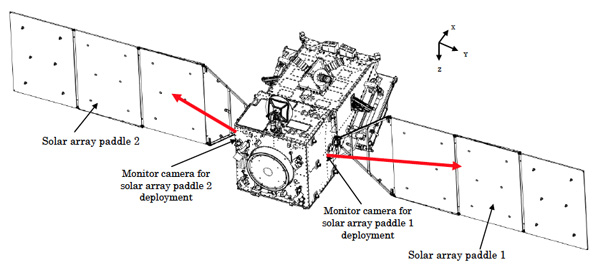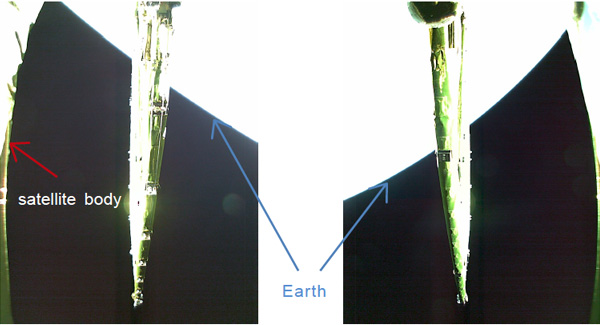DAICHI-2 (ALOS-2) Status and Orbit Calculation
May 24, 2014 (JST)
Japan Aerospace Exploration Agency
The Japan Aerospace Exploration Agency (JAXA) confirmed the current status of the Advanced Land Observing Satellite-2 "DAICHI-2" (ALOS-2), which JAXA launched on the H-IIA Launch Vehicle No. 24 from the Tanegashima Space Center at 12:05 p.m. on May 24, 2014 (Japan Standard time, JST.)
The deployment of the solar array paddles has been confirmed to have been performed in the sky over Australia at 12:30 p.m. on May 24 (JST) through telemetry received at the Perth station in Australia. The deployment images acquired at the Santiago station in Chile are attached below.
As a result of the orbit calculation results, the DAICHI-2 was injected into the following scheduled initial orbit.
The satellite is now in a stable condition.
Table Orbit Calculation Result
| Actual value | Scheduled value | |
|---|---|---|
| Apogee altitude | 647.4 km | 645.8 km |
| Perigee altitude | 629.8 km | 628.5 km |
| Inclination | 97.9 degrees | 97.9 degrees |
| Period | 97.5 minutes | 97.5 minutes |
(Next press release)
The next press release about the L-band synthetic aperture radar (PALSAR-2)*1 antenna deployment is scheduled to be issued at around 6:30 p.m. on May 26 (JST.)
*1 L-band synthetic aperture radar (PALSAR-2)
The Phased Array type L-band Synthetic Aperture Rader-2 (PALSAR-2) using the L-band microwave of 1.2 GHz band can perform observations regardless of weather conditions and the time of the day. The PALSAR-2 is a renovated version of the 10-meter resolution PALSAR installed on the DAICHI to acquire data with a resolution of one to three meters. The PALSAR-2 can also observe a wider range of about three times (870 kilometers to 2,320 kilometers observation swath) compared to the PALSAR, which could only view from its right side, by adding the observation function on both sides.
Attachment
Solar Array Paddle Deployment
Figure of the DAICHI-2 prior to solar array paddle deployment

Figure of the DAICHI-2 after solar array paddle deployment

Images taken by onboard monitor cameras (Images taken by monitor cameras for deployment aboard the DAICHI-2.*1)

Solar array paddle 2(-Y side) shot
by monitor camera *1
Solar array paddle 1(+Y side) shot
by monitor camera *1
*1: The above images are acquired by the monitor cameras for solar array paddle deployment in order to conduct a data transmission test between the satellite and the ground station.